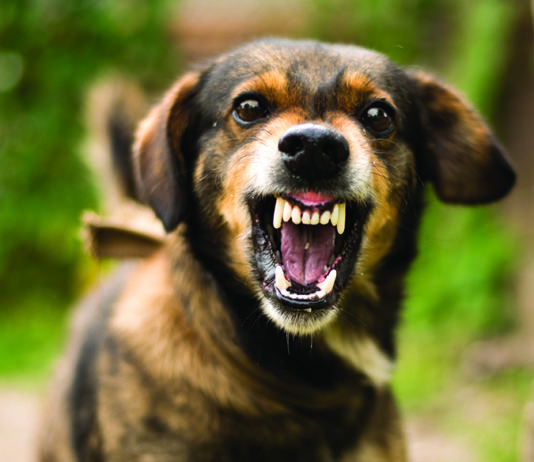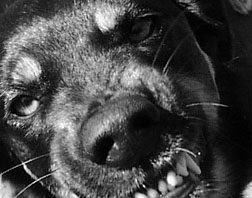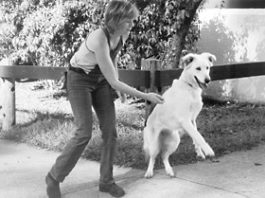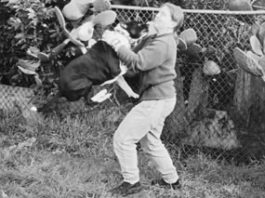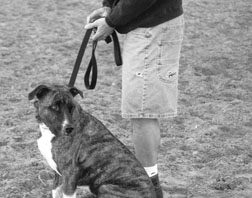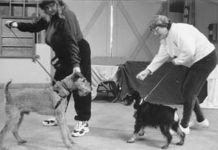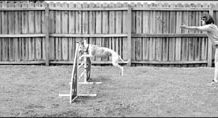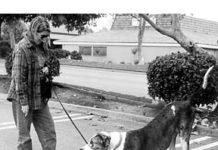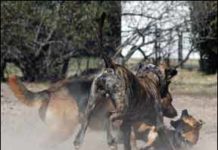Canine Class for Aggressive and Problematic Dogs
the focus is on gradually teaching dogs new and more appropriate responses to increasingly proximate contact with other dogs. Pupils begin learning new skills behind visual barriers
Comments on “Alpha” Dominance Theory
There is a growing body of information available to anyone who wants to learn more about why dominance theory is so outdated and incorrect. Here are 10 resources to get you started...
Agility Games for Managing Dog Aggression
Owning an aggressive, fearful, or other type of special needs" dog is stressful. When your dog overreacts to other dogs or just the stimulus of being out in the world by barking
Fear Aggression in Dogs
Fear-related aggression most frequently appears between the ages of eight to 18 months, as a young dog reaches maturity. This may be because increased boldness tends to come with maturity. But it's also likely because, over time, aggressive responses are reinforced; the scary stimulus (most often a human, when we're talking about aggression issues) backs off. Initially, a fearful pup generally tries to hide from scary humans by moving away, perhaps crawling under a chair.
Aggressive Behavior Information
It has become all too common to see lists of breed bans in multi-unit residences as well as municipalities. Books could be written about the drawbacks of breed-specific legislation (BSL), but suffice to say that all dogs have the potential to bite and no breed has 100 percent benign membership. The bully breed" lovers among us (count me in) would point out that many of these dogs are model citizens and great companions."
When Your Well-Trained Dog Turns Aggressive – Act Fast!
I first met Lucy at my local monthly “My Dog Can Do That” competition in January of 1998, at the SPCA in Monterey, California. She was easy to spot – a merle Great Dane with lovely natural ears, who literally towered above the competition. Lucy was attentive, responsive, performed even the most advanced MDCDT behaviors with ease, and consistently placed in the ribbons. It surprised me, then, when a few months later I heard Lucy had started threatening humans, and her aggression was escalating. This was not appropriate behavior for any dog, but particularly disturbing in one of Lucy’s size, with her potential for causing serious harm.
Solving Your Dog’s Behavior Problem Crisis
One of the most irritating and common phone calls I receive in my capacity as a professional dog trainer is when dog owners urgently ask me to help solve their dog's behavior problem immediately even though, as it often turns out, the problem has actually existed for years. Sometimes, it's even phrased as, If we can't get this fixed now
Counter-Conditioning and Desensitization for Reducing Dog Reactvity
Counter-conditioning involves changing your dog’s association with a scary or arousing stimulus from negative to positive. Desensitization is starting with a very low-level intensity of aversive stimulus until the dog habituates to (or changes his association with) the aversive, and then gradually increasing the strength until the dog is comfortable with the stimulus at full intensity. The easiest way to give most dogs a positive association and to help them become comfortable with a stimulus is with very high-value, really yummy treats. I like to use chicken – canned, baked, or boiled; most dogs love chicken. Here’s how the CC&D process works.
Qualified Professionals for Dog Aggression Modification
Mild aggression cases might involve a dog who growls and might even air-snap
Out For Blood
If your dogs are fighting, and are causing severe damage to each other – or one dog is causing severe damage to another – I’m sorry to say that you are dealing with the most difficult of all canine behavior problems, the one with the worst possible prognosis. Your options are extremely limited, because the treatment really should have happened when the dog was 4 1/2 months old, which is when dogs normally learn bite inhibition.
Unsticking Myths About Dogs
apprehensive
5 Ways to Break Up a Dog Fight
A dog fight that goes beyond a brief scuffle and doesn’t resolve quickly is frightening to behold. In fact, it’s one of the behavior scenarios most likely to result in significant injury to humans, not to mention the dogs. The first, most important thing to remember is keep yourself safe. After that, here are five things to do to try to end the conflict as quickly as possible, with minimal bloodshed.


